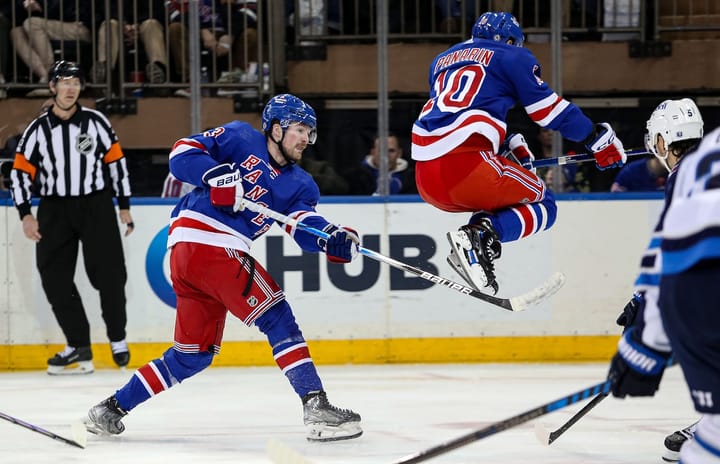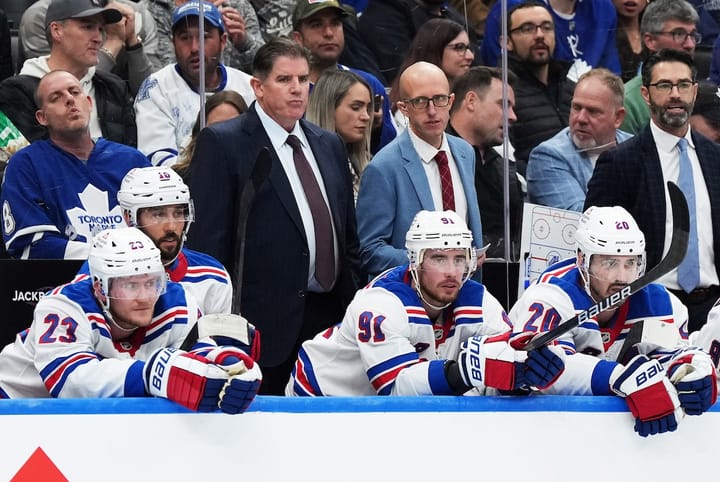Rangers Should Recall Igor Shesterkin Sooner Rather Than Later
The Blueshirts’ logjam in net will come to a head eventually, but there’s no reason to force the issue sooner than necessary
Since the NHL emerged from the 2004-05 lockout, the Rangers’ goaltending situation has been in good hands. Henrik Lundqvist emerged from the depths of the 7th round of the 2000 NHL Entry Draft, and established himself as the Blueshirts’ franchise netminder. While other goalies around the league have had better individual seasons over the last decade and a half, no one approaches the consistency that Lundqvist has brought to Broadway.
Thirteen consecutive 24+ win seasons to begin his career, eight seasons (seven in a row from 2009-2016) of a .920+ Save Percentage, five All-Star Game appearances, and a 2012 Vezina Trophy give Lundqvist all the accolades he needs in terms of basic statistics and media acknowledgements to prove his greatness.
Lundqvist is also the league leader in Goals Saved Above Average, Wins Above Replacement. and dFSv%, meaning no goalie has saved more goals over a league average goalie than Lundqvist dating back to the 2007-2008 campaign. Whether it’s boxcar numbers or more analytical metrics, Lundqvist is the king of both.
While some of those metrics are cumulative, Lundqvist’s place atop those lists speaks to the consistency and durability that his peers simply do not have. Carey Price was crowned the best goaltender in the world once upon a time, and the only list you’d find him on now is one discussing the worst contracts in the league. Corey Schneider had a half decade run as the most underrated goaltender in the league after succeeding Martin Brodeur, and he’s currently plying his trade in AHL Binghamton. Roberto Luongo was the only netminder who even approached Lundqvist in terms of consistent greatness and durability, and even he succumbed to injuries in each of his final three seasons in Florida before retiring this past summer.
So Corsica's data goes back to 2007 and the viz now goes back to cumulative data from 2007-Present.
— Tyler Kelley (@DocKelley41) January 4, 2019
Henrik Lundqvist's GSAA over that period is 221.58.
Next closest is Jaroslav Halak at 93.06. Absolutely insane.
Schneider, Bobrovsky, and Gibson round out the top 5. pic.twitter.com/JvxS977FyN
Unfortunately, Lundqvist’s time in New York is coming to an end sooner rather than later. Set to enter unrestricted free agency (and likely retirement) following the 2020-21 season at age 39, everybody can see the light at the end of the tunnel at this point. With a handful of upper echelon goaltenders throughout the prospect pipeline, as well as one possibly sitting at #2 on the NHL depth chart right now, decision time is drawing close.
While Alexandar Georgiev has done a respectable job as Lundqvist’s understudy since arriving on Broadway just in time for the 2018 fire sale, he isn’t the most intriguing goaltending prospect in the organization. That distinction belongs to Igor Shesterkin, a 4th round selection by the Blueshirts during the 2014 Entry Draft. After spending five post-draft seasons in Russia, the Rangers agreed to an entry-level contract with Shesterkin over the summer.
He’s helped propel the Hartford Wolfpack from a 29th place finish last season to 7th place league wide and 1st place in the Atlantic Division as of today. The only concerns about Shesterkin stemmed from primarily playing behind a stacked SKA St. Petersburg team, where he posted a .935 SV% in 117 (108 with SKA) games during his KHL career, including a ludicrous .953 SV% in 28 games last season.
Faced with the challenge of adjusting to the smaller, North American rinks, Shesterkin has proven himself up to the task thus far. Sporting a .927 SV% in 12 starts with the Wolfpack, he’s doing his part to bust the myth of European players struggling when they come across the pond. Having proven himself as an elite performer in Russian juniors, the KHL, and now the AHL, it’d be hard to argue against Shesterkin being an NHL caliber goaltender at this very moment.
Of the goaltending prospects in the organization, Shesterkin has the highest ceiling, and is the most NHL ready netminder not currently in the NHL. Georgiev’s play hasn’t been fantastic this season, but his overall body of work is solid. The 30 starts Georgiev made last year were the most of any non-Lundqvist goalie since Cam Talbot made 34 in 2014-15, and that required a freak neck injury that knocked Lundqvist out for seven weeks.
All of this is to say that Georgiev’s play up until now is more than deserving of an NHL roster spot. However, as Rangers fans know all too well, on-ice performance isn’t the only thing that determines who plays where. If the Rangers are shrewd, they’ll take advantage of the NHL’s rules regarding waiver eligibility, demote Georgiev to Hartford, and call up Shesterkin in the coming weeks to get their first meaningful look at him at the NHL level.
Tandem starters and backups
— Sean Tierney (@ChartingHockey) November 25, 2019
Crawford/Lehner has been an excellent tandem.
Greiss/Varlamov too.
Lundqvist has carried Georgiev. pic.twitter.com/Ik2xslGvWC
With the Seattle expansion draft looming, and a bevy of other capable goaltending prospects behind Shesterkin, Georgiev isn’t long for the Rangers’ organization. Just like Talbot and Antti Raanta before him, Georgiev is approaching the point where he’s most valuable to the Blueshirts as a trade chip rather than a good backup goaltender. Due to those factors, the sooner the Rangers can get Shesterkin playing time in the NHL and find out what he’s made of, the better.
So why demote Georgiev rather than trade him now? The trade market for goaltenders is perpetually lukewarm in this league, even more so for 1B/2A type goalies in the middle of the season. The market will be more robust in the offseason, so there’s no need to force a trade right now. As for waiver eligibility, Georgiev is an a unique position where he is currently exempt from them, but would finish the season requiring waivers to be sent down. Waiver eligibility is determined by years since since an entry-level contract, as well as NHL games played while under contract. Cap Friendly breaks it down as follows:
Georgiev signed his contract as a 21 year old goaltender which means that he would be exempt from waivers for a maximum of four years. However, with 53 games played as of now, Georgiev is only able to play in another seven games before losing his exemption. If David Quinn uses his goaltenders similarly to the first quarter of the season, Georgiev will lose his waiver exemption long before the trade deadline, putting the Rangers in a bind.
They’d either need to keep Shesterkin buried in the AHL for the entire season, or call him up and have him rotate with Georgiev from behind the bench to the press box. Carrying three goaltenders has been done before, most notably by the 2016-17 New York Islanders, but it’s far from an ideal situation.
Igor Shesterkin’s body of work as a professional goaltender suggests that he’s ready for the NHL right now, and that there’s a significant chance that he’s the best option to succeed Henrik Lundqvist when the sun sets on the king’s career. The only problem with that is simple: Goalies are voodoo.
The only way to confirm Shesterkin’s abilities is to get him starts in the best league in the world. Those starts will come will come at the cost of further development for Alexandar Georgiev, but tough decisions are made in the hockey world on a daily basis. Clearing the path for Shesterkin’s NHL journey to begin will be a tough decision to make, but it’s a necessary one. The sooner it happens, the better.
Data via Evolving Hockey, Corsica, and NHL.com



